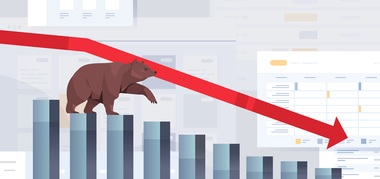Monster Bear Market Rallies May Be False Dawns
Markets never move in straight lines. Dramatic bear market rallies can make up many points of lost ground at warp speed. Investors pile in, driven by fear of missing out and other factors. Click through for some thoughts to help you remain a rational investor.
After a first burst of excitement, keen buyers may reconsider what happens in a rally. Have external conditions changed enough to warrant such a powerful move? Meanwhile, investment fund psychology reinforces the surge. A majority of funds are restricted from taking short positions anyhow or from holding cash over a certain level. Others bow to peer pressure, seeing the herd on the same bandwagon. They know they can get away with simply keeping up.
It’s not over till it’s over
The critical question is whether a fierce bear market rally is marking a major bottom or whether it is a temporary countertrend, doomed to reverse as the mood shifts. Keep in mind two related signals.
First, as a rule, bear markets do not die until investors raise the white flag of capitulation. That means they will have grown to hate stocks with a passion, sometimes even a generational mindset. Second, there would normally be a significant policy shift. For instance, in 1932, 2003 and 2009, stimulative monetary and fiscal policy reactions ushered in the end of brutal bear declines.
The process might theoretically unfold in three successive waves. To begin, the Federal Reserve could have been raising interest rates in an effort to control rampant inflation. In consequence, some form of recession might have resulted from tighter money. It is conceivable that something might then “break,” leading to a painful crunch in the credit markets. The Fed might possibly step in to lower rates, which would constitute a major policy shift. All that said, if the Fed could still somehow avoid recession, the bear might retreat, but it is a big “if.”
Meanwhile, during an upswing, investors look to trading patterns for confirmation clues of an inflection point. Does heavy volume suggest conviction? What is the percentage of stocks participating and the breadth of the movement? Patience is an important element. A genuine new bull market is generally considered a 20% sustained gain from the cycle low. A brief reprieve of a few days or weeks may not count.
Past is prologue
Market historians have a wealth of historical data on the past behavior of bear market rallies. Bull progressions tend to be methodical and steady, while bear trends trace more volatile and choppy paths. It is also notable that over the past 35 years, some of the most violent rallies occurred in 1987, 2002, 2008 and 2009, all during the most serious sell-offs.
Since the Nasdaq index was launched in 1971, there have been 26 days during which it added over 6% in a session. A whopping 77% of those days have occurred during bear downturns. In other words, that is three times as often as if one were counting across all market periods, both up and down.
We can parse some S&P numbers, too, for the frequency of powerful bear rallies.
- 1929-1931: five 20%+ rallies.
- 1937-1938: five 10%+ rallies.
- 2000-2002: four 10%+ rallies.
- 2007-2009: four 10%+ rallies.
How long did these upturns last? Many of these flashes in the pan could be measured in weeks, rather than months or quarters. Consider that during the tech crash, the four significant rallies lasted between two weeks and two and a half months. Later, during the decimating housing crash, four comebacks each persisted from one to two months.
Too good to be true
As of late 2022, the Fed was still hiking rates into an inverted yield curve, with short-term exceeding longer-term rates. (At the end of July 2023, the Fed raised rates again, to a range of 5.25 to 5.5 percent.) That atypical rate relationship can slow economic activity as banks cut back on lending. When irrational exuberance is prevailing in a bear climate, ask yourself some tough questions about what could go wrong.
- Is inflation still high?
- Is corporate capital spending slowing?
- Are profit margins shrinking or expanding?
- Are growth expectations realistic?
If you are wondering whether market upswings are truly giving you a signal to invest, it may be time for a conversation with your financial adviser.
©2023
